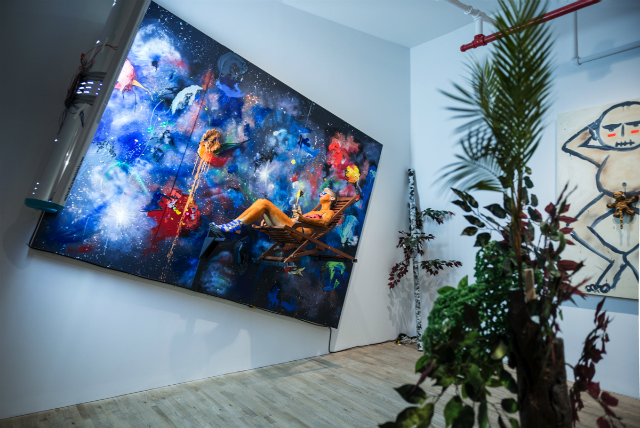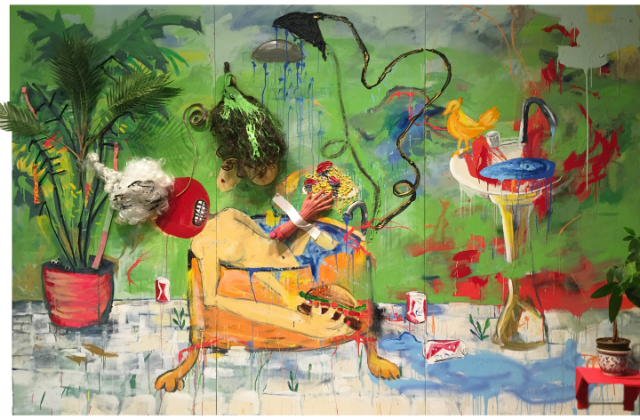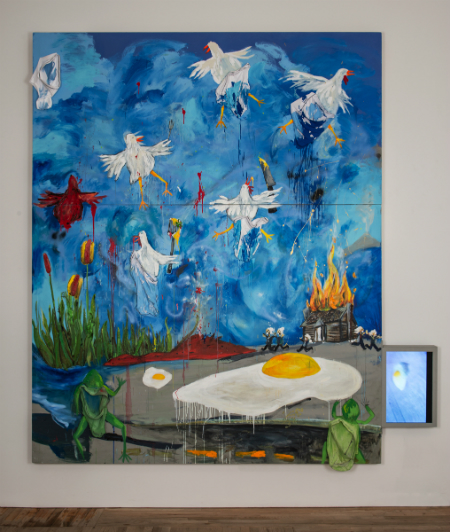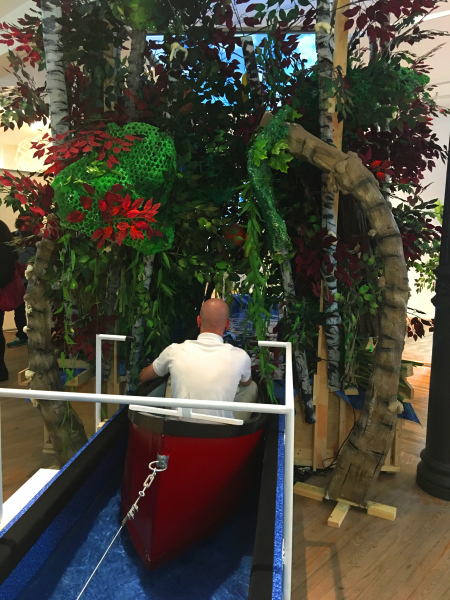
“Tanning bed with ambience (Luminiferous aether) with Tea Hacic” (2016), acrylic and spray paint on canvas with tanning bed, relaxation chair, cactus. 96 x 132 x 36 inches.
Anyone who’s seen Jennifer Catron and Paul Outlaw’s work, has zero chance of forgetting it. In the past, their work has involved placing a dinner table and its diners on a hydraulic lift, live chickens, pig fountains, a crawfish food truck, a tour Chelsea tour bus that sold editioned knock offs of famous artworks, and a gallery-sized art-world themed Monopoly game board activated by actual players. That’s not even half of the work they’ve produced.
The point of all this, is to poke fun at contemporary American culture and question the belief systems that inform it. Their current show at Postmasters, “Behold! I teach you the Overman!”, uses their trademark high-energy approach to art making to great effect. It engulfs viewers in installation, video, painting, and performance that simultaneously criticize and celebrate the role of decadence in life and art. It includes a chair that lifts you upward into a ceiling mounted video viewing cube. Inside, a parade of morally ambiguous leaders and characters engage in heavenly glee while consuming mounds of food. In the middle of the gallery, a freestanding grove of trees cover an artificial pond with a functioning boat ride. The forest’s canopy consists of a multi-media video piece starring Catron and Outlaw. In it, an intergalactic sunbathing chair propels an orange-tanned woman towards the intense light of an overpowering tanning bed, alluding to either a nuclear doomsday, or spacial bliss.
When I sat down with Jen and Paul, we discussed the themes running through their current show – namely the human necessity for belief in higher powers and how it influences and shapes our culture. The conversation began on a topic close to my own practice, painting!

“8 Thermidor Year CCXXIV Houseplant for your house” (2016), oil and acrylic on canvas, with fishbowl, wigs, houseplant, grow light. 84 x 120 x 15 inches.
Irena Jurek: In your current solo show at Postmasters, you added painting into the mix of your incredibly varied interdisciplinary practice. Can you talk about the process that goes into making these new paintings?
Jennifer Catron: We’ll take turns starting the painting, then alternate painting on top of each other’s work. It can be a really stressful moment for me when Paul starts wielding his paintbrush, but at the same time it removes the preciousness of the painting. The concepts behind the paintings, we discuss, all the actual painting can be very spontaneous.
Paul Outlaw: These paintings are like everything else we do, total collaborations. We’re definitely working against each other and with each other. These paintings are a record of that studio practice that we have of two people sharing the same studio together constantly.
Your collaborations provide such a contrast to the typical, solitary ego found in most art!
JC: Yes! And it’s oddly a relief. This was actually the first time we painted together. I have to give props to Paul, since it was his idea for us to start painting.
It’s refreshing to see work that can be simultaneously critical and hilarious. I’m thinking specifically here of the stuffed animal tiger you attached to a stick figure painting of a dude, but also the painting with the giant egg landscape and sky filled with birds. Although the paintings are self-conscious, they aren’t ironic. Your maximalist approach makes it seem like just about anything can enter your work! These paintings implement readymades such as underwear, video monitors, and even a functioning kitchen sink!
JC: There’s such a fine line you have to walk when you use humor, and we discuss this often, what’s too far?

“SOSsoso,” (2016),
oil and acrylic on canvas, with men’s underwear, video monitor and video. 120 x 96 inches.
Another idea that you brought up in relation to your show is this idea of mayhem.
PO: There are a few different levels in this show represented by the pieces and the paintings, and one of these levels is this mayhem and chaotic situation that we’ve created that involves all these iconic figures throughout history and present day.
JC: It’s creating this weird mythology between the past, the present, and potentially the future. In creating these weird relationships and stories, drawing parallels between, there’s a certain mayhem that prevails. It’s abject, it’s frightening at times and it’s also ridiculous.
PO: It’s gross and disgusting! Moral ambiguity is also a theme that we’ve chosen for these characters and what they’re doing.
We talked a little bit about belief before. There’s this tension within all of your work between the futility of everything, but also about the beauty and complexity of everything.
JC: And we believe in both those things!
Those are opposite sides of the same coin.
PO: And we’re very much opposite sides of the same coin, because I do want to believe in everything and Jen’s much more of a skeptic or a realist. In other ways I’m a total nihilist. I want to believe, but another side of me knows that a lot of this does not matter or will not matter.

Installation view of Behold! I teach you the Overman!, 2016.
Of course! How can you be alive now, and not have that conflict on some level?
JC: I think that some people have more internal conflict than others. We both grew up in very religious and wonderful homes. It was very important in shaping me; I don’t want to speak for you Paul. Belief was such a huge part of my life growing up, and I’ve always been interested in the correlation of morality and its relationship to infinite living. I do still believe (and we are using the term very broadly), but it’s easy to see how a person’s inherent need to belief can also be their demise.
PO: The concept of a belief system that we’re talking about is very important to the show. The beliefs that we grew up with, and that informed our society from the very beginning, often involves the concept that if you do something wrong, you’ll have to pay for it. That’s often not true, or maybe it’s never true. Maybe you never pay for evil deeds.
That’s what people want to believe. People really want to believe in justice. Yet there is this sense that even the greatest atrocities eventually get washed over by time.
JC: Right. That’s a belief in itself. It’s more beautiful; you can step outside the atrocities.
PO: When we often think of time, we think that things won’t matter a hundred years from now, but in today’s society it often won’t matter thirty minutes from now.

“Gotterdammerung” (2016), four channel HD video and mixed media sculpture with chairlift. 13 x 7 x 7 feet, video in edition of 5 + AP.
It’s wild how maximalist your vision becomes; it’s very cinematic!
JC: We do that often. Taking one large leap outside your time can be very healthy for our work. It can also get very specific. In one of the pieces we’re working on, the characters are specific to their time. We are calling out people and the atrocities that they have committed.
PO: All these characters are atrocious to some people, and heroes to others, depending on your point of view.
In a way you’re also deconstructing value systems.
JC: Right, because morality is relative depending on which culture you grew up in.
History itself is often fabricated, even if you have access to multiple interpretations of looking at it.
JC: Absolutely! For me it was shocking to go to college and to be taught history in such a different way than I had learned it in grammar school and high school.
PO: We’re told these stories, we’re told that they are true, and we’re taught to believe in them, to keep society chugging along, and to maintain the status quo.

Installation view. 2016.
You guys are questioning these beliefs that are founded in lies, and yet on some level we need these lies in order for society to function.
JC: Right. We need the political process, we need order, and we need to believe that the system is going to work otherwise it becomes anarchy. I despise so many things about it, and yet simultaneously believe in its ultimate goal of organization.
PO: These stories that bind us together are ridiculous. Religion is the original story that keeps us in line, and that makes civilization possible. We still have a need as a species to believe in religion.
Yes, that’s true of anything. Believing in art even.
PO: I have a need to believe in religion.
JC: If you start disbelieving in one thing, you have to believe in another, even if it’s that there is no such thing. It’s human nature. I really do think that people replace one set of beliefs with another.
Aside from these themes of belief, it also seems like you place a lot of emphasis on the individualistic experience of your audience in this show.
PO: Two of the major pieces in the show revolve around the individualistic experience of the viewer. Only one person gets to experience the artwork at a singular time, which does put an emphasis on that person’s viewing experience. They’re able to leave their peer group, which also eliminates any distractions.
There seems to be something very ritualistic and transformative about that.
JC: Right, definitely. Ritual is a part of it, and these pieces seem religious already. So the idea of allowing us to put you in whatever apparatus we decide to put you in, and experience whatever amount of time we have set forth for this is a ritual; it feels important.


Comments on this entry are closed.